Menus
- Uncovered driving fun on the country road
- Despite ten years of maturation, nobody is perfect
- Data Kawasaki Z 1000 (2004/2014)
- Rating Kawasaki Z 1000 (2004/2014)
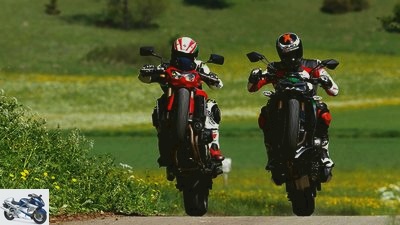
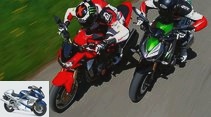
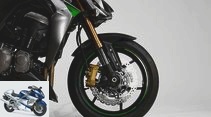
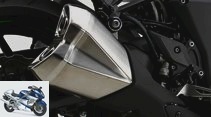
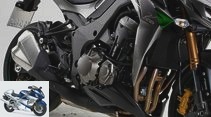
16 photos
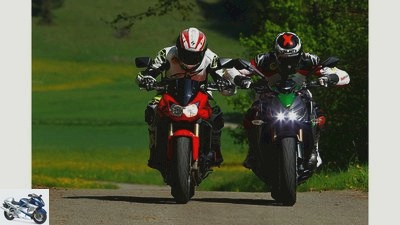
1/16
Memories of the old Z 900 and Z 1000 times were awakened by the “four-in-two-in-four exhaust system” with its four individual rear silencers, and the old tale of “Frankenstein’s daughter” was immediately back on the table.
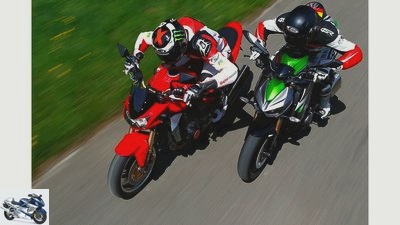
2/16
So the young Z has an easy job, hurrying confidently. Grandma only comes closer again on wrinkled asphalt and narrow country roads of the third order.
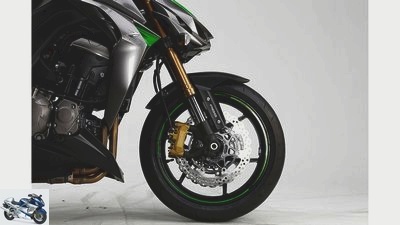
3/16
The wave optics of the new brake have a racer-like effect, the effect is very good.
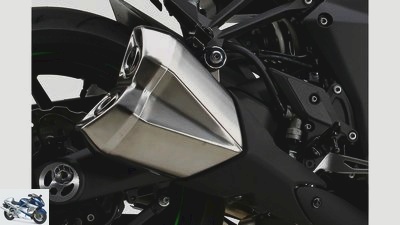
4/16
The new exhaust looks very massive. Both Kawas are pleasantly quiet.
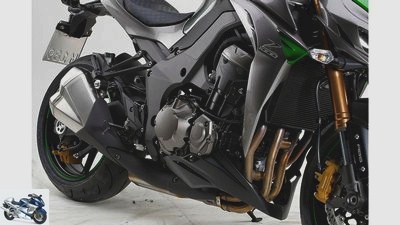
5/16
The engine of the new Zett has a shorter gear ratio and is more dynamic than that of the 2004.
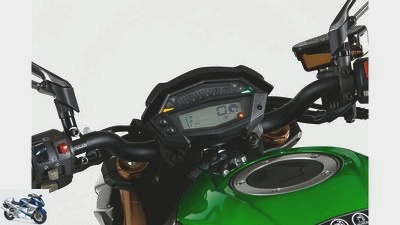
6/16
The Z cockpits have always been designed independently.
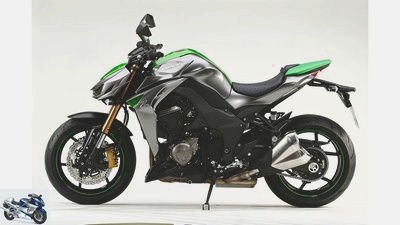
7/16
Only the wide opening of the damping on the fork lets you calm down and makes the Z a popular companion even on bumpy slopes.
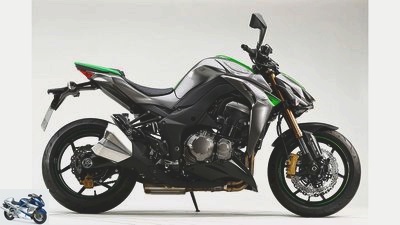
8/16
The current Z 1000 is unnecessarily tightly tuned and then sometimes behaves so stubbornly that the pilot loses sight and hearing.
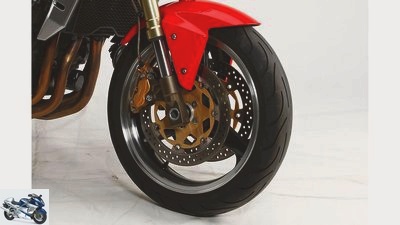
9/16
The chassis of the old Zett is far too soft, the brakes of our test bike too blunt.
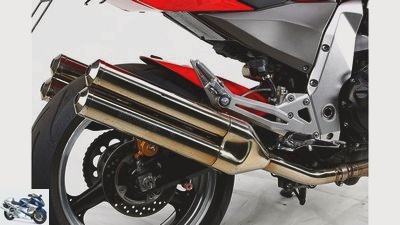
10/16
Clear victory for the 04er-Zett. The exhaust is more filigree.
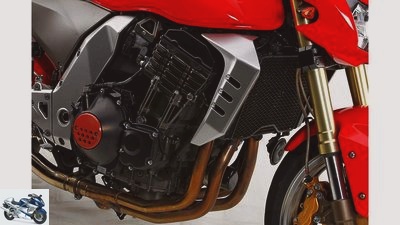
11/16
Power plant versus air pump: No, the old Z-engine isn’t that slow either.
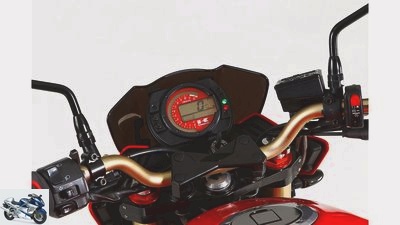
12/16
The design has always stood out for the Z cockpits.
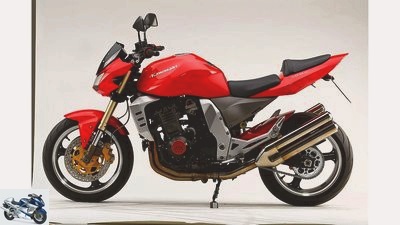
13/16
The modern Zetts have nothing more to do with Frankenstein or the wicked driving behavior of the first Z generation in 1976, but they have nothing to do with undisguised driving fun on the country road.
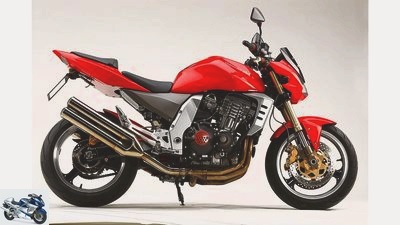
14/16
The applause was frenetic when in 2003 the “new” Kawasaki Z 1000 came onto the market. The brand’s fans were euphoric, the trade press delighted by the brand’s impulsive appearance, and many motorcyclists became Zett knights within a very short time.
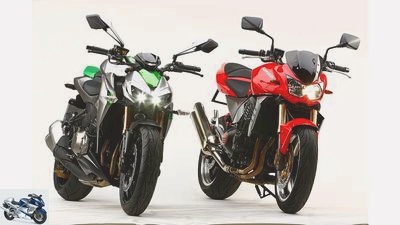
15/16
Since then, the “new” Z 1000 is not that new and with its smaller sister, formerly the Z 750 and now the Z 800, has become a mainstay of the Kawasaki model range.
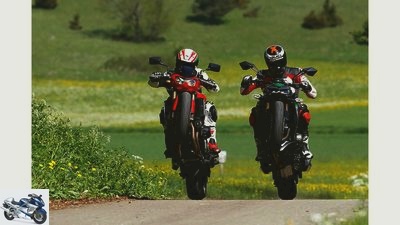
16/16
The Z 1000 has made real progress in ten years.
Kawasaki Z 1000 – model years 2004 and 2014 in a comparison test
Uncovered driving fun on the country road
Content of
The renewed Kawasaki Z 1000 came onto the market a good ten years ago. Fans and the trade press were equally enthusiastic. PS compared the 2004 Z 1000 with the current model and shows the differences.
The applause was frenetic when in 2003 the “new” Kawasaki Z 1000 came onto the market. The brand’s fans were euphoric, the trade press delighted by the brand’s impulsive appearance, and many motorcyclists became Zett knights within a very short time. Memories of the old Z 900 and Z 1000 times were awakened by the “four-in-two-in-four exhaust system” with its four individual rear silencers, and the old tale of “Frankenstein’s daughter” was immediately back on the table . Since then, the “new” Z 1000 is no longer so new and with its smaller sister, formerly the Z 750 and now the Z 800, has become a mainstay of the Kawasaki model range. The modern Zetts have nothing more to do with Frankenstein or the wicked driving behavior of the first Z generation in 1976, but they have nothing to do with undisguised driving fun on the country road.
Buy complete article
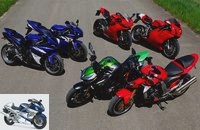
Ducati 999/1199, Kawasaki Z 1000 and Yamaha YZF-R1
Generation comparison – 10 years apart
Kawasaki Z 1000 combines an engine derived from the ZX-9R engine with a tame center and agile, powerful top end with a very soft suspension, while the modern Zett embeds a very high-torque and high-torque engine in a very stiff chassis. And that’s exactly how grandma and great-grandchildren drive themselves. The Omchen has to be turned and spun, if things are to move quickly, the granddaughter shakes off intermediate sprints and overtaking maneuvers without shifting. The engines remained true to one another on one point. Neither the 2004 nor the 2014 engine are vibration-free. These vibrations seem to be part of the Z 1000 genetics like the four mufflers, the fat rear tire, the beefy overall package and the strikingly styled lamp mask.
Despite ten years of maturation, nobody is perfect
Off to the country road, a short family trip is on the agenda. Under normal traffic conditions, the grandma stays close on the heels of the grandson. Only on empty slopes like in the northern Black Forest does the old lady find herself increasingly short of breath. Her granddaughter, who has been very briefly translated and showing off her forcefully, stands up and away. Even increased switching work and permanent speeds of over 7000 tours only help to a limited extent to stay within striking distance. The chassis of the old Zett is far too soft, the brakes of our test bike too blunt. So the young Z has an easy job, hurrying confidently. Grandma only comes closer again on wrinkled asphalt and narrow country roads of the third order. Because the current Kawasaki Z 1000 is unnecessarily tightly tuned and then sometimes behaves so stubbornly that the pilot loses hearing and seeing. Only the wide opening of the damping on the fork lets you calm down and makes the Z a popular companion even on bumpy slopes.
The fact that no one is perfect despite ten years of maturity can be seen in two other points on the current Z 1000. First: The new gearbox (380 km on the speedometer) is very difficult to shift; Second: The alignment of the handlebar fittings on the new one is crap. Either the levers are far too high and you can see something in the rear-view mirrors, or you can operate the levers (to do this you have to loosen the armature a little and turn it forwards) and see nothing in the mirrors. But apart from that, the Kawasaki Z 1000 has made real headway in ten years.
All used offers: Kawasaki Z 1000
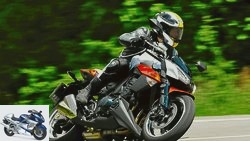
Naked bike
Endurance test final balance of the Kawasaki Z 1000
The naked bike after 50,000 km
read more
Data Kawasaki Z 1000 (2004/2014)
MOTORCYCLE
The performance data of the Kawasaki Z 1000.
Kawasaki Z 1000 (2004)
| drive | Four-cylinder in-line engine, four valves / cylinder, 93 kW (127 hp) at 10,000 rpm *, 96 Nm at 8000 rpm *, 953 cm³, bore / stroke: 77.2 / 50.9 mm, Compression ratio: 11.2: 1, ignition / injection system, 38 mm throttle valves, mechanically operated multi-disc oil bath clutch, six-speed gearbox, G-Kat, chain |
| chassis & Brakes |
Tubular steel bridge frame, steering head angle: 66.0 degrees, Trail: 101 mm, wheelbase: 1420 mm, upside-down fork, Ø inner fork tube: 41 mm, adjustable in spring base and rebound. Central spring strut with deflection, adjustable in spring base and rebound. Front / rear suspension travel: 120/138 mm, cast light alloy wheels, 3.50 x 17 / 6.00 x 17, front tires: 120/70 ZR 17, rear: 190/50 ZR 17, Michelin Pilot Power “E” test tires, 300 mm double disc brakes with four-piston fixed calipers at the front, 220 mm single disc with Single-piston floating caliper at the rear |
| performance | |
| Max. Rear wheel power ** | 90.0 kW (122 PS) at 236 km / h |
| Acceleration** | 0-100 km / h: 3.1 s 0–150 km / h: 5.6 s 0-200 km / h: 9.9 s |
| Draft** | 50-100 km / h: 5.2 s 100-150 km / h: 5.4 s |
| Top speed * | 245 km / h |
| measurements and weight | Length / width / height: 2040/760/1250 mm, seat / handlebar height: 805/995 mm Handlebar width: 685 mm, 224 kg with a full tank, v./h .: 49.6 / 50.4% |
| consumption | Fuel type: Super unleaded. Average test consumption: 7.6 liters / 100 km, Tank capacity: 18 liters, range: 237 km |
| Set up | |
| Setup fork | stat. neg. spring travel: 35 mm, pressure level: -, Rebound stage: completely closed, level: standard |
| Setup shock absorber | stat. neg.spring travel: 15 mm, pressure level: -, Rebound stage: 1 U open, level: standard |
| Base price (2004) | 9990 euros (including additional costs) |
| All damping settings counted from completely closed; static negative spring deflection standing vertically without driver; U = revolutions; K = clicks; * Manufacturer information; ** PS measurement |
|
Kawasaki Z 1000 (2014)
| drive | Four-cylinder in-line engine, four valves / cylinder, 104 kW (142 hp) at 10,000 rpm *, 111 Nm at 7300 rpm *, 1043 cm³, bore / stroke: 77.0 / 56.0 mm, compression ratio: 11.8: 1, ignition / injection system, 38 mm throttle valves, mechanically operated multi-disc oil bath clutch, six-speed gearbox, G-Kat, chain |
| chassis & Brakes |
Light alloy backbone frame, steering head angle: 65.5 degrees,
Trail: 101 mm, wheelbase: 1435 mm, upside-down fork,
Inner fork tube: 41 mm, adjustable in spring base, rebound and compression.
Central spring strut with deflection, adjustable in spring base and rebound.
Suspension travel front / rear: 120/122 mm, cast light alloy wheels, 3.50 x 17 / 6.00 x 17,
Front tires: 120/70 ZR 17, rear: 190/50 ZR 17, first tires: Dunlop D 214 “T”,
310 mm double disc brake with radially attached four-piston fixed calipers at the front, 250 mm single disc with single-piston floating caliper at the rear, ABS
0–150 km / h: 5.6 s
0-200 km / h: 10.0 s
100-150 km / h: 3.7 s
Handlebar width: 710 mm, 222 kg with a full tank, v./h .: 50.2 / 49.8%
Compression stage: completely open, rebound stage: 4.5 U open, level: standard
Rebound: 4.25 U open, level: standard
without driver; U = revolutions; K = clicks; * Manufacturer information; ** PS measurement
Rating Kawasaki Z 1000 (2004/2014)
The “new” Z 1000 is not that new anymore and with its smaller sister, formerly the Z 750 and now the Z 800, has become a mainstay of the Kawasaki model range.
| Max. Points |
Kawasaki Z 1000 (2004) |
Kawasaki Z 1000 (2014) |
|
| drive |
|||
| acceleration | 10 | 7th | 7th |
| Draft | 10 | 5 | 9 |
| Power delivery | 10 | 6th | 8th |
| Responsiveness | 10 | 7th | 7th |
| Load change reaction | 10 | 6th | 7th |
| Running culture | 10 | 4th | 6th |
| Gear actuation | 10 | 7th | 5 |
| Gear ratio | 10 | 7th | 9 |
| Clutch function | 10 | 6th | 6th |
| Traction control | 10 | – | – |
| Subtotal |
100 |
55 |
64 |
| landing gear |
|||
| Driving stability | 10 | 6th | 7th |
| Handiness | 10 | 7th | 7th |
| Cornering stability | 10 | 6th | 8th |
| feedback | 10 | 6th | 8th |
| Suspension tuning in front | 10 | 6th | 8th |
| Chassis set-up at the rear | 10 | 6th | 7th |
| Braking effect | 10 | 7th | 9 |
| Brake metering | 10 | 7th | 9 |
| Erection moment when braking |
10 | 6th | 5 |
| ABS function | 10 | – | 9 |
| Subtotal |
100 |
57 |
77 |
| Everyday life and driving fun | |||
| Sitting position | 10 | 7th | 8th |
| Windbreak | 10 | 2 | 1 |
| Furnishing | 10 | 3 | 5 |
| consumption | 10 | 5 | 6th |
| Driving fun | 10 | 6th | 8th |
| Subtotal |
50 |
23 |
28 |
| Total |
250 |
135 |
168 |
| placement |
2. |
1. |
|
Related articles
-
Comparison test Kawasaki Z 1000 old against new
Jahn 30 pictures Jahn 1/30 We are used to the fact that the Z 1000 has been in the thick of things since its rebirth in 2003. After all, since then it has been known as …
-
Comparison test: Honda CB 1000 R, Yamaha FZ1, Triumph Speed Triple, Kawasaki Z 1000
Comparison test: Honda CB 1000 R, Yamaha FZ1, Triumph Speed Triple, Kawasaki Z 1000 Large naked bikes in comparison Contents of …
-
Comparison test: super sports cars under 1000 cubic meters from MV Agusta, Ducati and Kawasaki
Jahn 46 pictures Jahn 1/46 Kawasaki ZX-6R 636 Jahn 2/46 But the Evo is not alone in this. All three bikes rock the ring during the test. Jahn 3/46 ……
-
Ducati 999-1199, Kawasaki Z 1000 and Yamaha YZF-R1 in a comparison test
fact Ducati 999/1199, Kawasaki Z 1000 and Yamaha YZF-R1 Generation comparison – 10 years apart Contents of Ten years is a long time since …
-
Kawasaki ZX-10R and BMW S 1000 RR in a comparison test
www.bilski-fotografie.de 25 pictures www.bilski-fotografie.de 1/25 Let’s first take a look at the new Kawasaki ZX-10R. www.bilski-fotografie.de …
-
EBR 1190 SX, Kawasaki Z 1000, Triumph Speed Triple in the test
fact 31 pictures fact 1/31 Triumph Speed Triple. fact 2/31 EBR 1190 SX. fact 3/31 EBR 1190 SX. fact 4/31 EBR 1190 SX. fact 5/31 EBR 1190 SX. fact 6/31 fact …
-
Ducati Monster 821 and Kawasaki Z 800 in comparison test
Bilski 34 pictures Bilski 1/34 Kawasaki Z 800. Bilski 2/34 Ducati Monster 821 and Kawasaki Z 800 in the comparison test. Bilski 3/34 Ducati Monster 821 and …
-
Triumph Tiger 1050 Sport against Kawasaki Z 1000 SX in comparison test
17th photos 1/17 Comparison test between Kawasaki Z 1000 SX and Triumph Tiger 1050 Sport. 2/17 Faster wheel…
-
Comparison test between Kawasaki ZX-9R and Suzuki TL 1000 R
Comparison test between Kawasaki ZX-9R and Suzuki TL 1000 R How to take it? Finally: the Suzuki TL 1000 R wants to make V-twin fascination affordable. Two-…
-
Jahn comparison test of supersports: Ducati 998, Honda Fireblade, Kawasaki ZX-9R, Suzuki GSX-R 1000, Triumph Daytona 955i Centennial The K-Question Five …